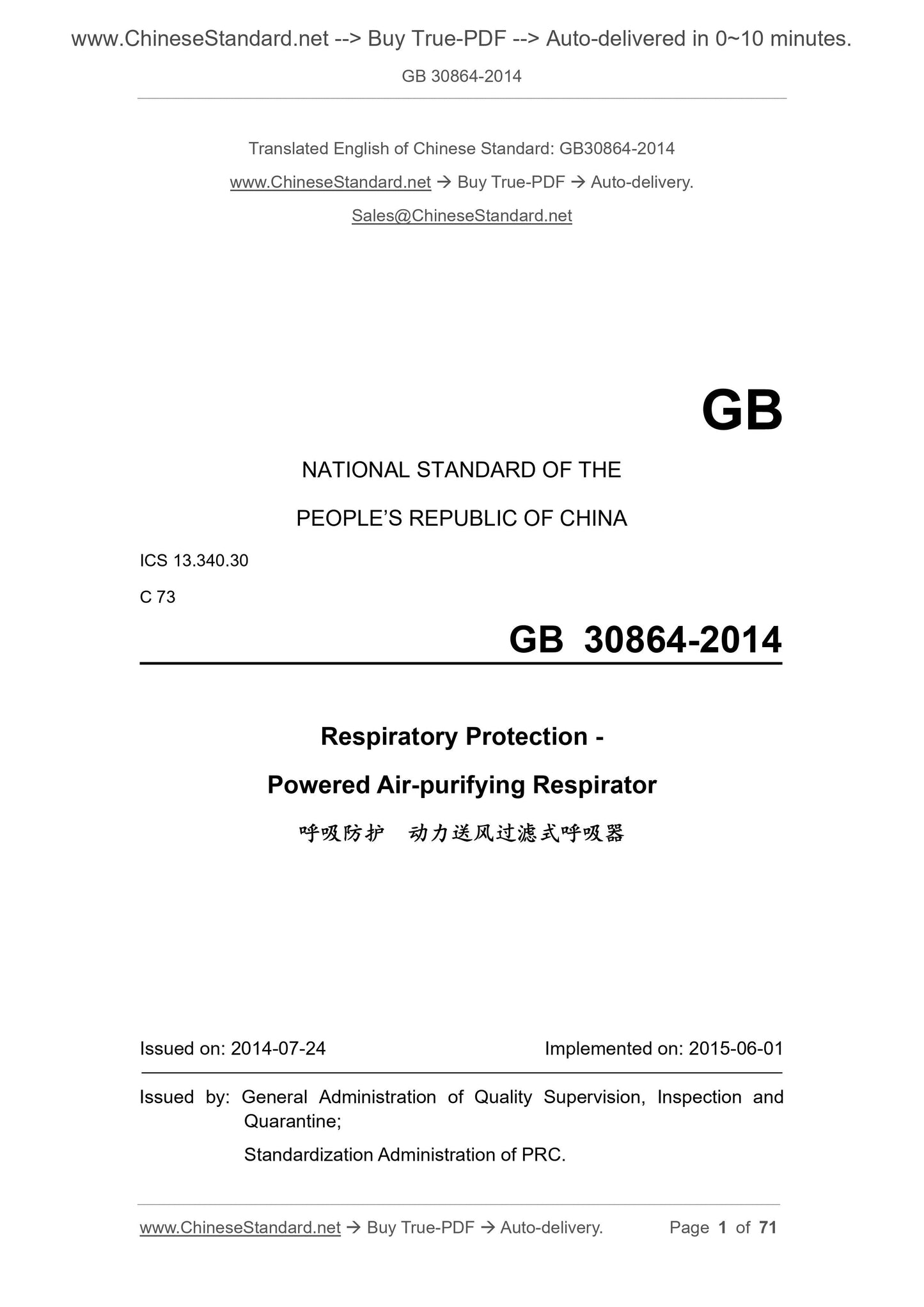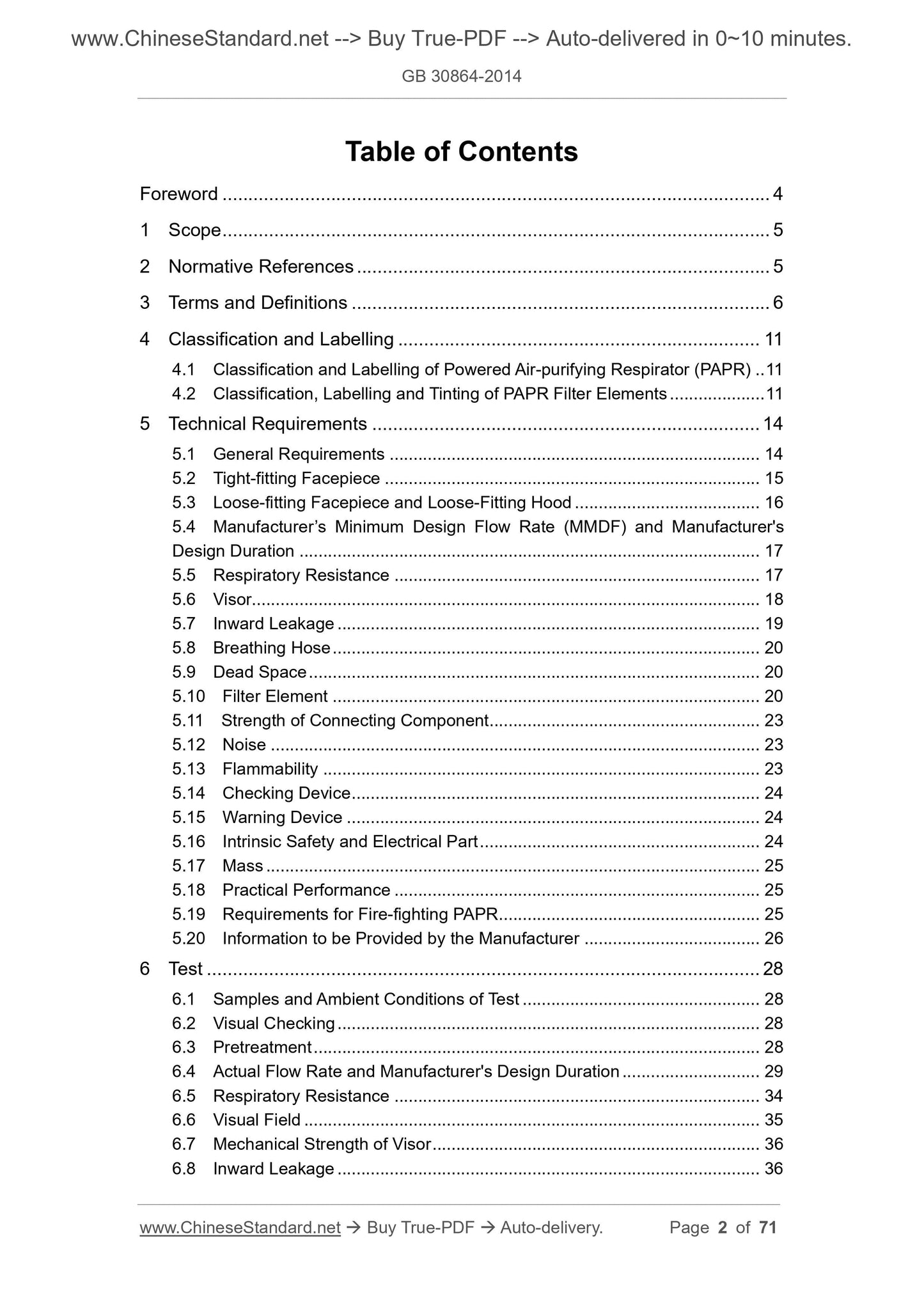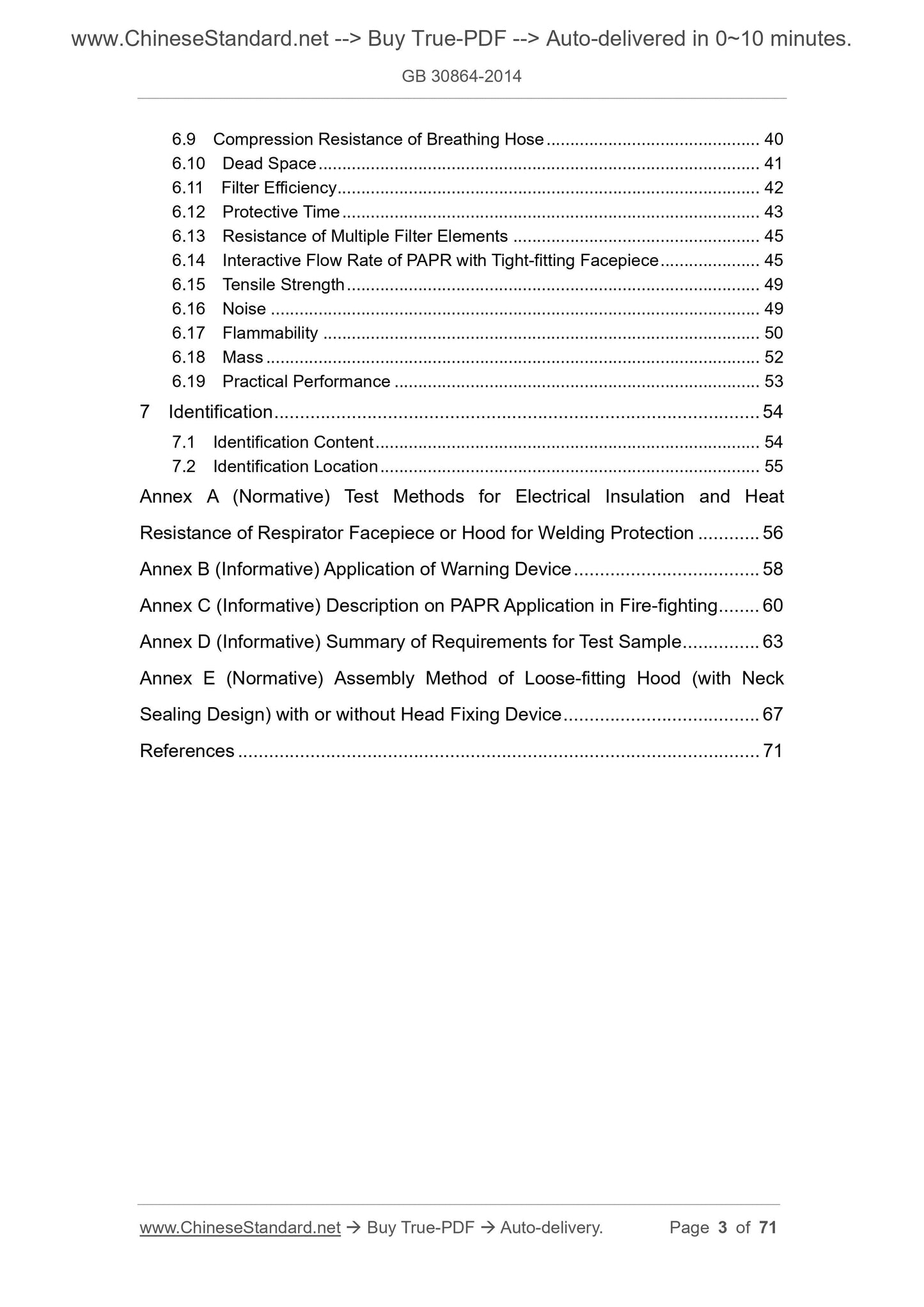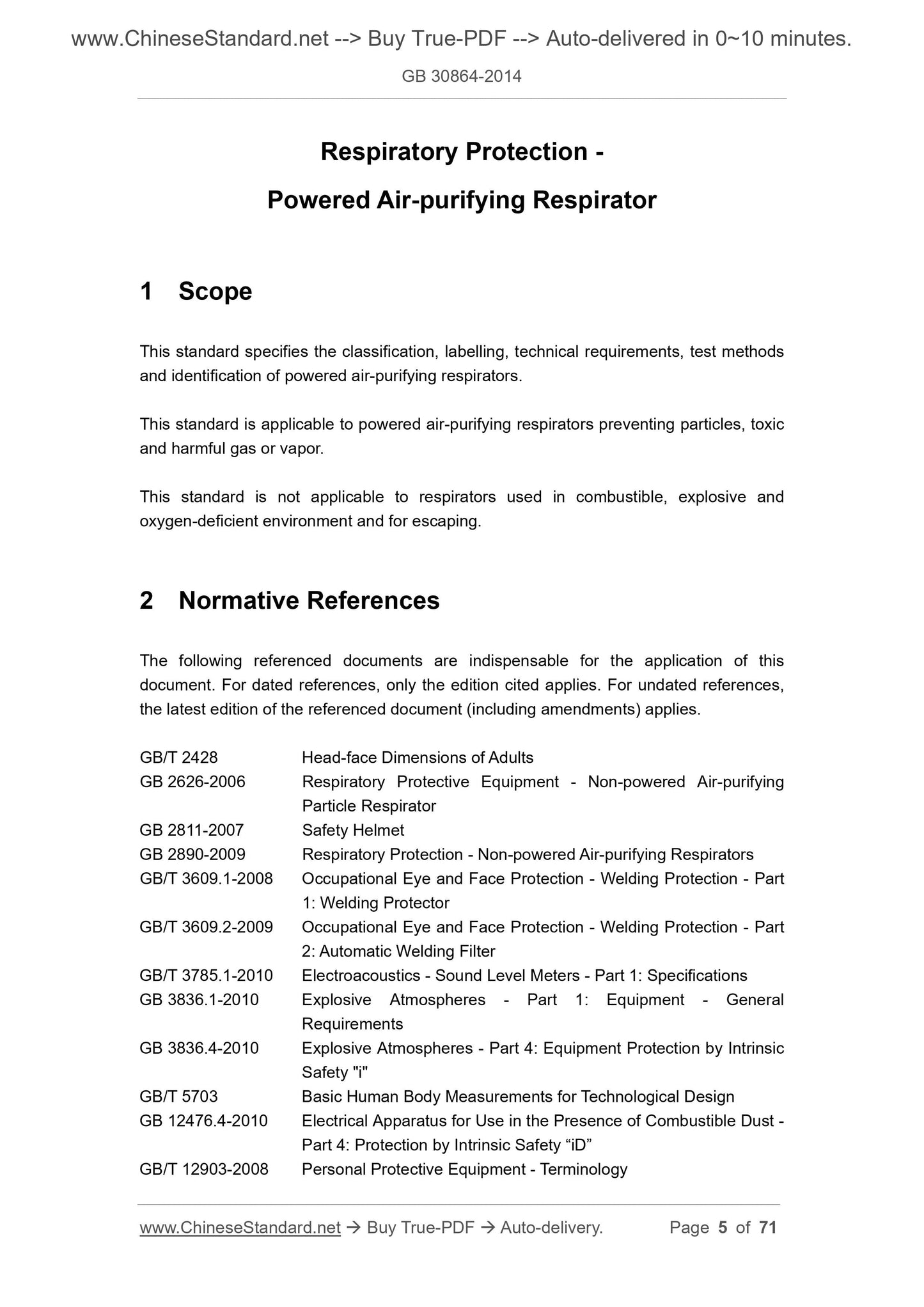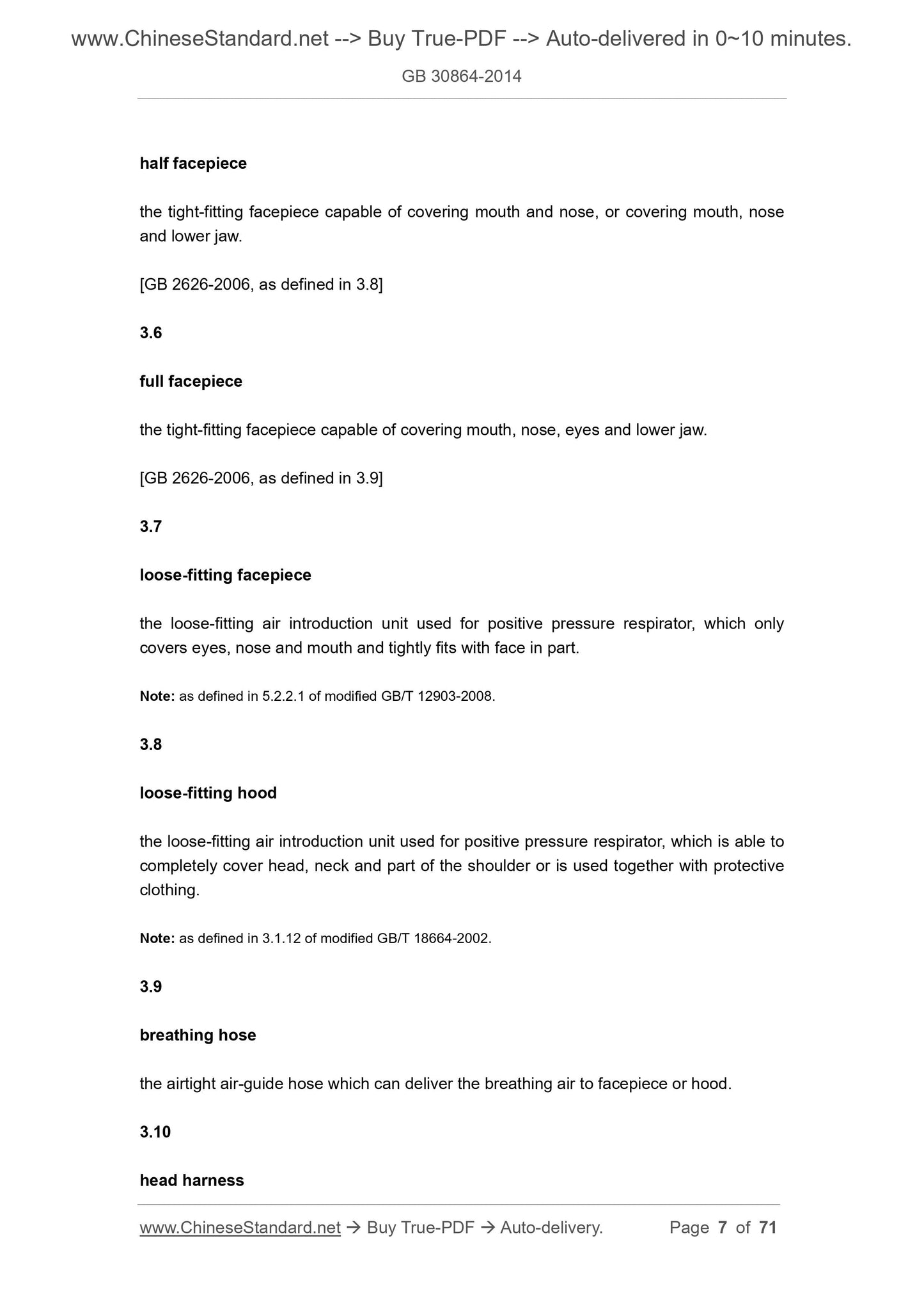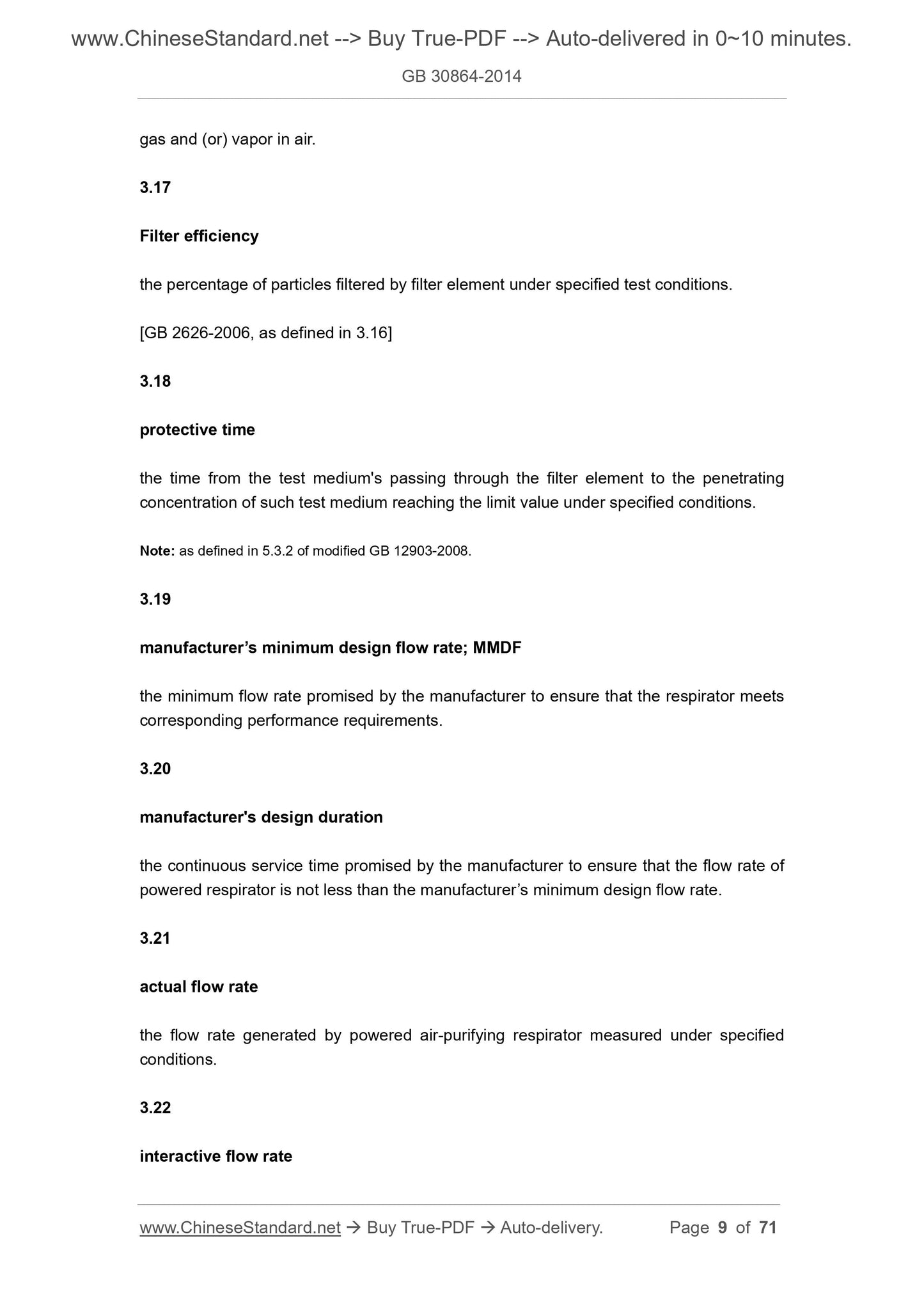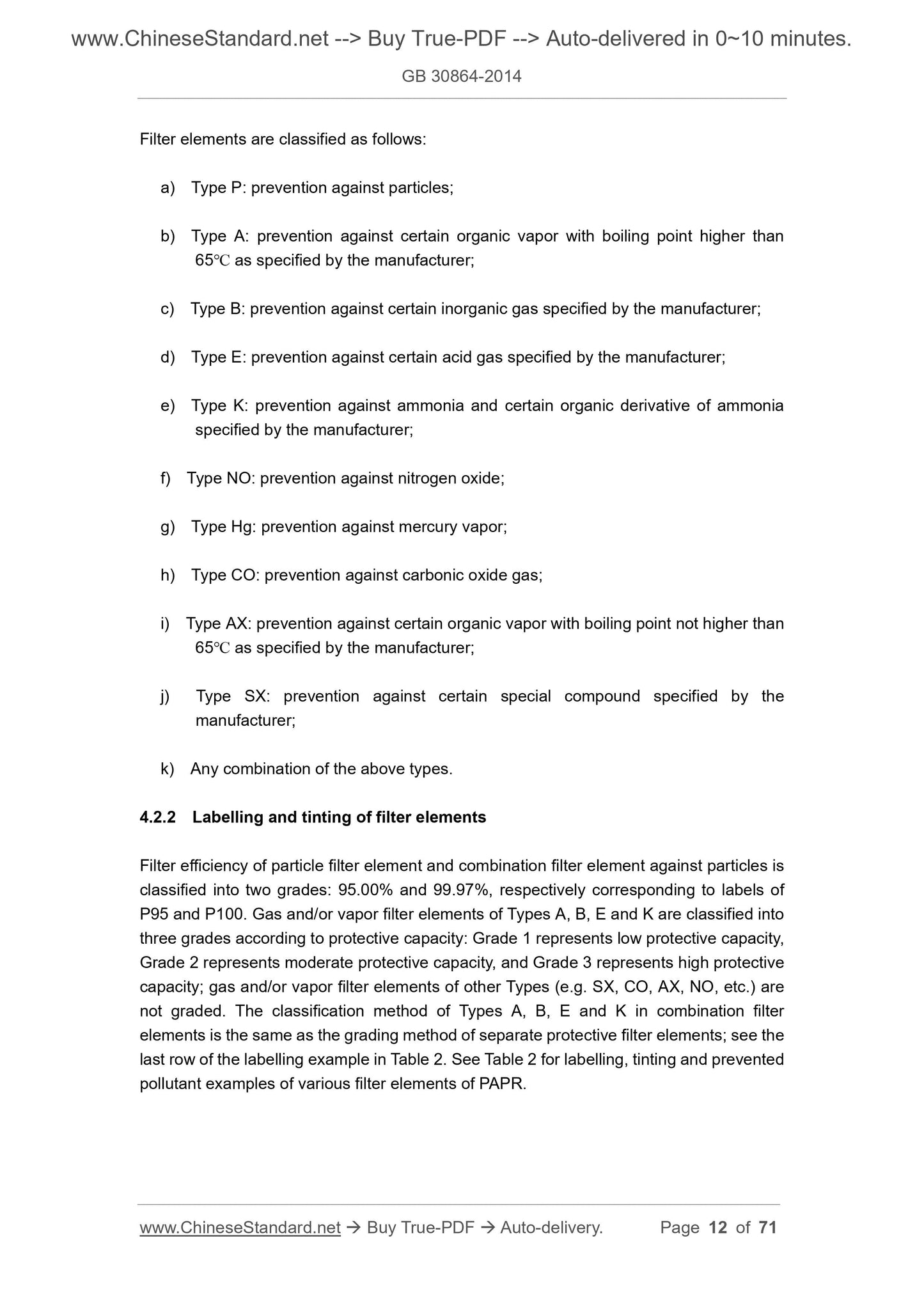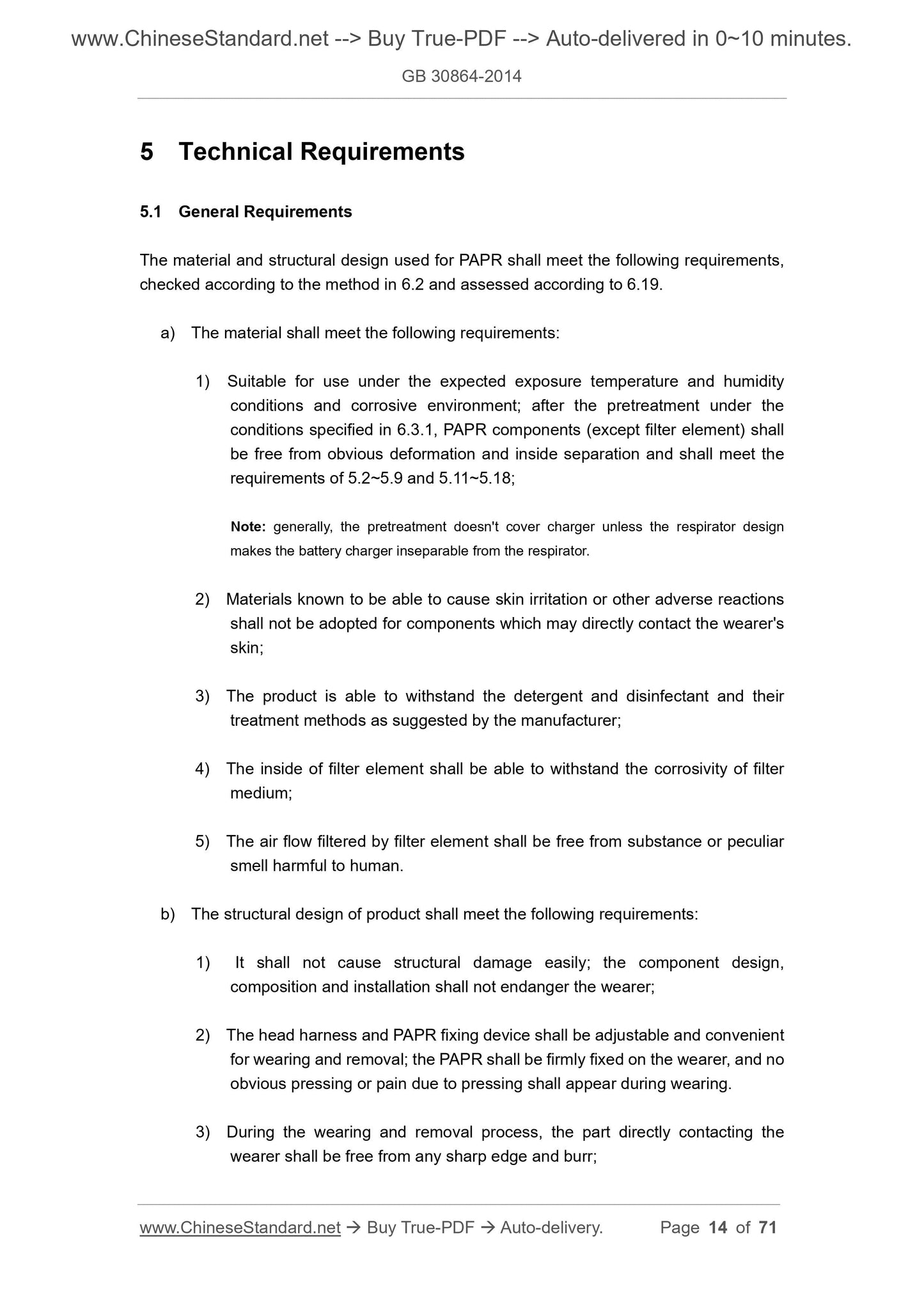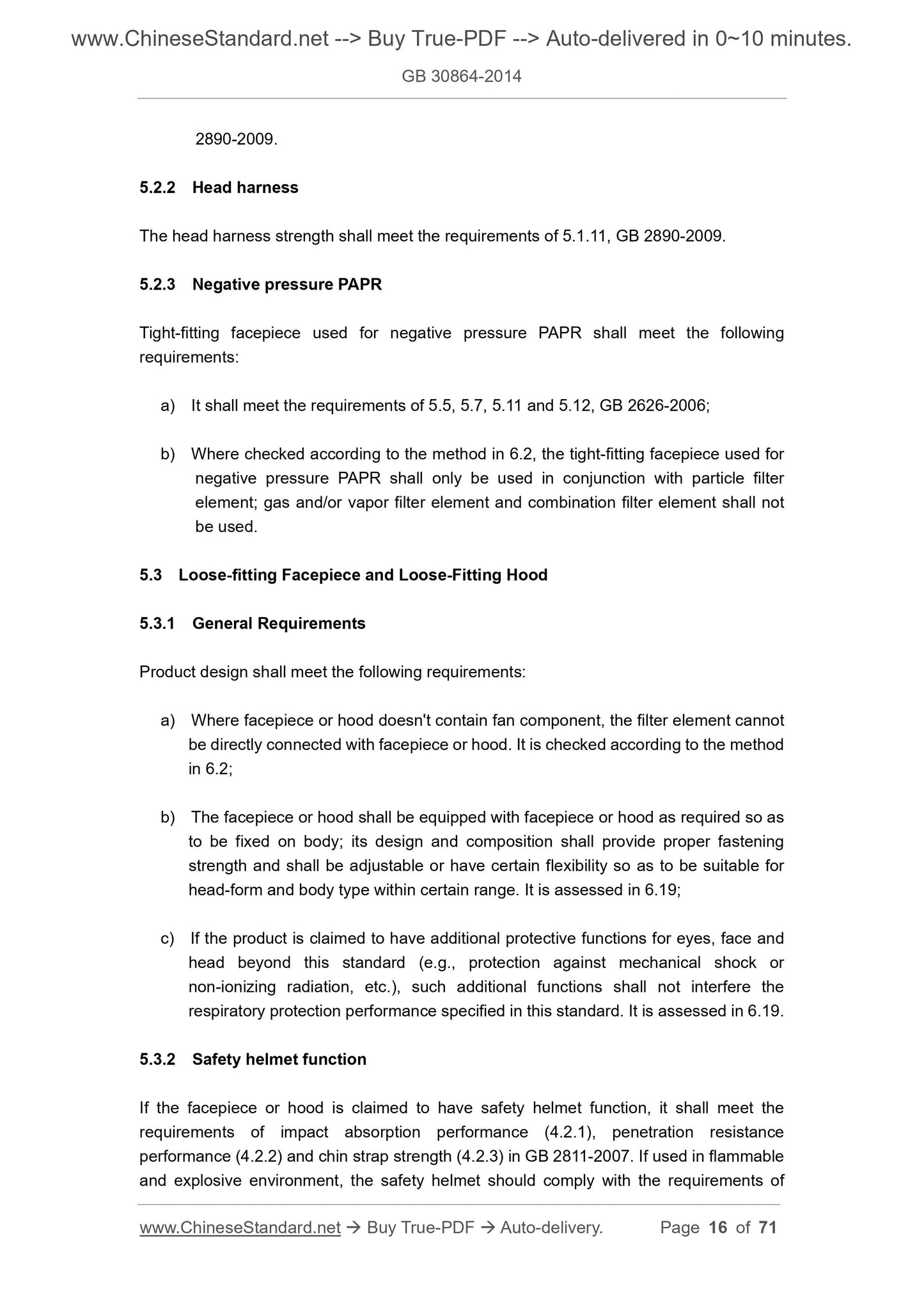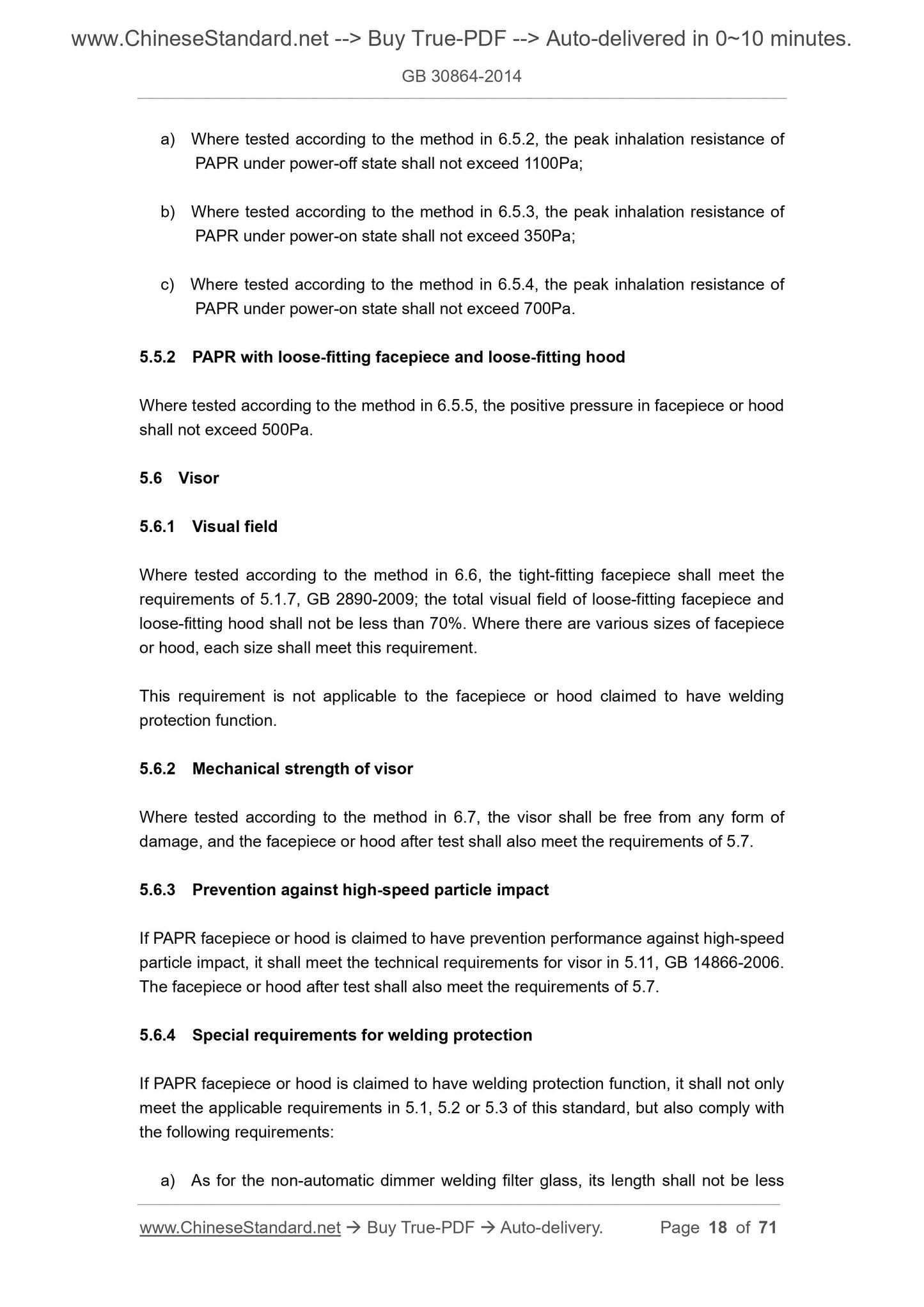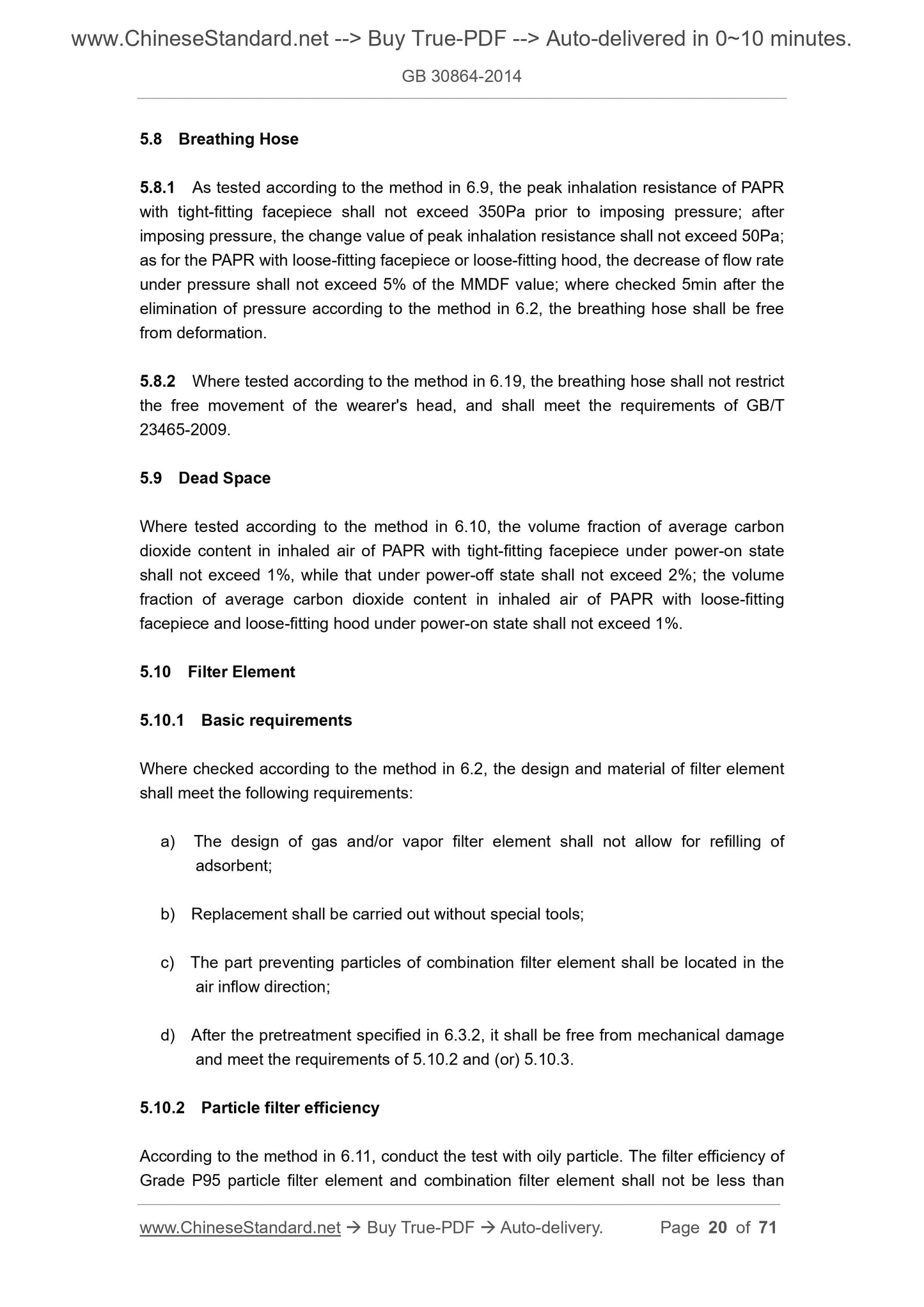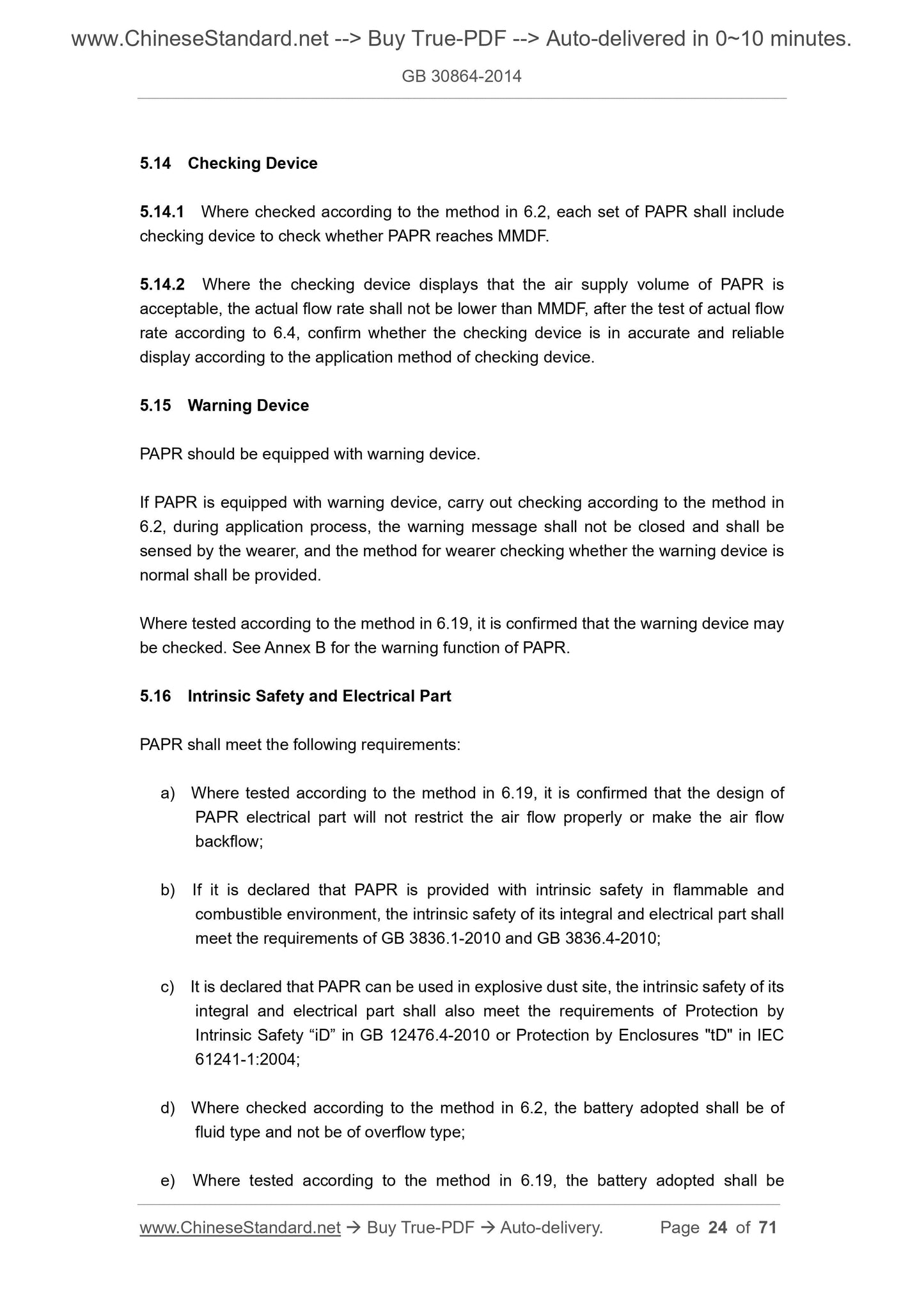1
/
of
12
PayPal, credit cards. Download editable-PDF and invoice in 1 second!
GB 30864-2014 English PDF
GB 30864-2014 English PDF
Regular price
$345.00 USD
Regular price
Sale price
$345.00 USD
Unit price
/
per
Shipping calculated at checkout.
Couldn't load pickup availability
Delivery: 3 seconds. Download true-PDF + Invoice.
Get QUOTATION in 1-minute: Click GB 30864-2014
Historical versions: GB 30864-2014
Preview True-PDF (Reload/Scroll if blank)
GB 30864-2014: Respiratory protection -- Powered air-purifying respirator
GB 30864-2014
NATIONAL STANDARD OF THE
PEOPLE’S REPUBLIC OF CHINA
ICS 13.340.30
C 73
Respiratory Protection -
Powered Air-purifying Respirator
ISSUED ON: 2014-07-24
IMPLEMENTED ON: 2015-06-01
Issued by: General Administration of Quality Supervision, Inspection and
Quarantine;
Standardization Administration of PRC.
Table of Contents
Foreword ... 4
1 Scope ... 5
2 Normative References ... 5
3 Terms and Definitions ... 6
4 Classification and Labelling ... 11
4.1 Classification and Labelling of Powered Air-purifying Respirator (PAPR) .. 11
4.2 Classification, Labelling and Tinting of PAPR Filter Elements ... 11
5 Technical Requirements ... 14
5.1 General Requirements ... 14
5.2 Tight-fitting Facepiece ... 15
5.3 Loose-fitting Facepiece and Loose-Fitting Hood ... 16
5.4 Manufacturer’s Minimum Design Flow Rate (MMDF) and Manufacturer's
Design Duration ... 17
5.5 Respiratory Resistance ... 17
5.6 Visor... 18
5.7 Inward Leakage ... 19
5.8 Breathing Hose ... 20
5.9 Dead Space ... 20
5.10 Filter Element ... 20
5.11 Strength of Connecting Component ... 23
5.12 Noise ... 23
5.13 Flammability ... 23
5.14 Checking Device ... 24
5.15 Warning Device ... 24
5.16 Intrinsic Safety and Electrical Part ... 24
5.17 Mass ... 25
5.18 Practical Performance ... 25
5.19 Requirements for Fire-fighting PAPR ... 25
5.20 Information to be Provided by the Manufacturer ... 26
6 Test ... 28
6.1 Samples and Ambient Conditions of Test ... 28
6.2 Visual Checking ... 28
6.3 Pretreatment ... 28
6.4 Actual Flow Rate and Manufacturer's Design Duration ... 29
6.5 Respiratory Resistance ... 34
6.6 Visual Field ... 35
6.7 Mechanical Strength of Visor ... 36
6.8 Inward Leakage ... 36
6.9 Compression Resistance of Breathing Hose ... 40
6.10 Dead Space ... 41
6.11 Filter Efficiency ... 42
6.12 Protective Time ... 43
6.13 Resistance of Multiple Filter Elements ... 45
6.14 Interactive Flow Rate of PAPR with Tight-fitting Facepiece ... 45
6.15 Tensile Strength ... 49
6.16 Noise ... 49
6.17 Flammability ... 50
6.18 Mass ... 52
6.19 Practical Performance ... 53
7 Identification ... 54
7.1 Identification Content ... 54
7.2 Identification Location ... 55
Annex A (Normative) Test Methods for Electrical Insulation and Heat
Resistance of Respirator Facepiece or Hood for Welding Protection ... 56
Annex B (Informative) Application of Warning Device ... 58
Annex C (Informative) Description on PAPR Application in Fire-fighting ... 60
Annex D (Informative) Summary of Requirements for Test Sample ... 63
Annex E (Normative) Assembly Method of Loose-fitting Hood (with Neck
Sealing Design) with or without Head Fixing Device ... 67
References ... 71
Respiratory Protection -
Powered Air-purifying Respirator
1 Scope
This standard specifies the classification, labelling, technical requirements, test methods
and identification of powered air-purifying respirators.
This standard is applicable to powered air-purifying respirators preventing particles, toxic
and harmful gas or vapor.
This standard is not applicable to respirators used in combustible, explosive and
oxygen-deficient environment and for escaping.
2 Normative References
The following referenced documents are indispensable for the application of this
document. For dated references, only the edition cited applies. For undated references,
the latest edition of the referenced document (including amendments) applies.
GB/T 2428 Head-face Dimensions of Adults
GB 2626-2006 Respiratory Protective Equipment - Non-powered Air-purifying
Particle Respirator
GB 2811-2007 Safety Helmet
GB 2890-2009 Respiratory Protection - Non-powered Air-purifying Respirators
GB/T 3609.1-2008 Occupational Eye and Face Protection - Welding Protection - Part
1: Welding Protector
GB/T 3609.2-2009 Occupational Eye and Face Protection - Welding Protection - Part
2: Automatic Welding Filter
GB/T 3785.1-2010 Electroacoustics - Sound Level Meters - Part 1: Specifications
GB 3836.1-2010 Explosive Atmospheres - Part 1: Equipment - General
Requirements
GB 3836.4-2010 Explosive Atmospheres - Part 4: Equipment Protection by Intrinsic
Safety "i"
GB/T 5703 Basic Human Body Measurements for Technological Design
GB 12476.4-2010 Electrical Apparatus for Use in the Presence of Combustible Dust -
Part 4: Protection by Intrinsic Safety “iD”
GB/T 12903-2008 Personal Protective Equipment - Terminology
half facepiece
the tight-fitting facepiece capable of covering mouth and nose, or covering mouth, nose
and lower jaw.
[GB 2626-2006, as defined in 3.8]
3.6
full facepiece
the tight-fitting facepiece capable of covering mouth, nose, eyes and lower jaw.
[GB 2626-2006, as defined in 3.9]
3.7
loose-fitting facepiece
the loose-fitting air introduction unit used for positive pressure respirator, which only
covers eyes, nose and mouth and tightly fits with face in part.
Note: as defined in 5.2.2.1 of modified GB/T 12903-2008.
3.8
loose-fitting hood
the loose-fitting air introduction unit used for positive pressure respirator, which is able to
completely cover head, neck and part of the shoulder or is used together with protective
clothing.
Note: as defined in 3.1.12 of modified GB/T 18664-2002.
3.9
breathing hose
the airtight air-guide hose which can deliver the breathing air to facepiece or hood.
3.10
head harness
gas and (or) vapor in air.
3.17
Filter efficiency
the percentage of particles filtered by filter element under specified test conditions.
[GB 2626-2006, as defined in 3.16]
3.18
protective time
the time from the test medium's passing through the filter element to the penetrating
concentration of such test medium reaching the limit value under specified conditions.
Note: as defined in 5.3.2 of modified GB 12903-2008.
3.19
manufacturer’s minimum design flow rate; MMDF
the minimum flow rate promised by the manufacturer to ensure that the respirator meets
corresponding performance requirements.
3.20
manufacturer's design duration
the continuous service time promised by the manufacturer to ensure that the flow rate of
powered respirator is not less than the manufacturer’s minimum design flow rate.
3.21
actual flow rate
the flow rate generated by powered air-purifying respirator measured under specified
conditions.
3.22
interactive flow rate
Filter elements are classified as follows:
a) Type P: prevention against particles;
b) Type A: prevention against certain organic vapor with boiling point higher than
65℃ as specified by the manufacturer;
c) Type B: prevention against certain inorganic gas specified by the manufacturer;
d) Type E: prevention against certain acid gas specified by the manufacturer;
e) Type K: prevention against ammonia and certain organic derivative of ammonia
specified by the manufacturer;
f) Type NO: prevention against nitrogen oxide;
g) Type Hg: prevention against mercury vapor;
h) Type CO: prevention against carbonic oxide gas;
i) Type AX: prevention against certain organic vapor with boiling point not higher than
65℃ as specified by the manufacturer;
j) Type SX: prevention against certain special compound specified by the
manufacturer;
k) Any combination of the above types.
4.2.2 Labelling and tinting of filter e...
Get QUOTATION in 1-minute: Click GB 30864-2014
Historical versions: GB 30864-2014
Preview True-PDF (Reload/Scroll if blank)
GB 30864-2014: Respiratory protection -- Powered air-purifying respirator
GB 30864-2014
NATIONAL STANDARD OF THE
PEOPLE’S REPUBLIC OF CHINA
ICS 13.340.30
C 73
Respiratory Protection -
Powered Air-purifying Respirator
ISSUED ON: 2014-07-24
IMPLEMENTED ON: 2015-06-01
Issued by: General Administration of Quality Supervision, Inspection and
Quarantine;
Standardization Administration of PRC.
Table of Contents
Foreword ... 4
1 Scope ... 5
2 Normative References ... 5
3 Terms and Definitions ... 6
4 Classification and Labelling ... 11
4.1 Classification and Labelling of Powered Air-purifying Respirator (PAPR) .. 11
4.2 Classification, Labelling and Tinting of PAPR Filter Elements ... 11
5 Technical Requirements ... 14
5.1 General Requirements ... 14
5.2 Tight-fitting Facepiece ... 15
5.3 Loose-fitting Facepiece and Loose-Fitting Hood ... 16
5.4 Manufacturer’s Minimum Design Flow Rate (MMDF) and Manufacturer's
Design Duration ... 17
5.5 Respiratory Resistance ... 17
5.6 Visor... 18
5.7 Inward Leakage ... 19
5.8 Breathing Hose ... 20
5.9 Dead Space ... 20
5.10 Filter Element ... 20
5.11 Strength of Connecting Component ... 23
5.12 Noise ... 23
5.13 Flammability ... 23
5.14 Checking Device ... 24
5.15 Warning Device ... 24
5.16 Intrinsic Safety and Electrical Part ... 24
5.17 Mass ... 25
5.18 Practical Performance ... 25
5.19 Requirements for Fire-fighting PAPR ... 25
5.20 Information to be Provided by the Manufacturer ... 26
6 Test ... 28
6.1 Samples and Ambient Conditions of Test ... 28
6.2 Visual Checking ... 28
6.3 Pretreatment ... 28
6.4 Actual Flow Rate and Manufacturer's Design Duration ... 29
6.5 Respiratory Resistance ... 34
6.6 Visual Field ... 35
6.7 Mechanical Strength of Visor ... 36
6.8 Inward Leakage ... 36
6.9 Compression Resistance of Breathing Hose ... 40
6.10 Dead Space ... 41
6.11 Filter Efficiency ... 42
6.12 Protective Time ... 43
6.13 Resistance of Multiple Filter Elements ... 45
6.14 Interactive Flow Rate of PAPR with Tight-fitting Facepiece ... 45
6.15 Tensile Strength ... 49
6.16 Noise ... 49
6.17 Flammability ... 50
6.18 Mass ... 52
6.19 Practical Performance ... 53
7 Identification ... 54
7.1 Identification Content ... 54
7.2 Identification Location ... 55
Annex A (Normative) Test Methods for Electrical Insulation and Heat
Resistance of Respirator Facepiece or Hood for Welding Protection ... 56
Annex B (Informative) Application of Warning Device ... 58
Annex C (Informative) Description on PAPR Application in Fire-fighting ... 60
Annex D (Informative) Summary of Requirements for Test Sample ... 63
Annex E (Normative) Assembly Method of Loose-fitting Hood (with Neck
Sealing Design) with or without Head Fixing Device ... 67
References ... 71
Respiratory Protection -
Powered Air-purifying Respirator
1 Scope
This standard specifies the classification, labelling, technical requirements, test methods
and identification of powered air-purifying respirators.
This standard is applicable to powered air-purifying respirators preventing particles, toxic
and harmful gas or vapor.
This standard is not applicable to respirators used in combustible, explosive and
oxygen-deficient environment and for escaping.
2 Normative References
The following referenced documents are indispensable for the application of this
document. For dated references, only the edition cited applies. For undated references,
the latest edition of the referenced document (including amendments) applies.
GB/T 2428 Head-face Dimensions of Adults
GB 2626-2006 Respiratory Protective Equipment - Non-powered Air-purifying
Particle Respirator
GB 2811-2007 Safety Helmet
GB 2890-2009 Respiratory Protection - Non-powered Air-purifying Respirators
GB/T 3609.1-2008 Occupational Eye and Face Protection - Welding Protection - Part
1: Welding Protector
GB/T 3609.2-2009 Occupational Eye and Face Protection - Welding Protection - Part
2: Automatic Welding Filter
GB/T 3785.1-2010 Electroacoustics - Sound Level Meters - Part 1: Specifications
GB 3836.1-2010 Explosive Atmospheres - Part 1: Equipment - General
Requirements
GB 3836.4-2010 Explosive Atmospheres - Part 4: Equipment Protection by Intrinsic
Safety "i"
GB/T 5703 Basic Human Body Measurements for Technological Design
GB 12476.4-2010 Electrical Apparatus for Use in the Presence of Combustible Dust -
Part 4: Protection by Intrinsic Safety “iD”
GB/T 12903-2008 Personal Protective Equipment - Terminology
half facepiece
the tight-fitting facepiece capable of covering mouth and nose, or covering mouth, nose
and lower jaw.
[GB 2626-2006, as defined in 3.8]
3.6
full facepiece
the tight-fitting facepiece capable of covering mouth, nose, eyes and lower jaw.
[GB 2626-2006, as defined in 3.9]
3.7
loose-fitting facepiece
the loose-fitting air introduction unit used for positive pressure respirator, which only
covers eyes, nose and mouth and tightly fits with face in part.
Note: as defined in 5.2.2.1 of modified GB/T 12903-2008.
3.8
loose-fitting hood
the loose-fitting air introduction unit used for positive pressure respirator, which is able to
completely cover head, neck and part of the shoulder or is used together with protective
clothing.
Note: as defined in 3.1.12 of modified GB/T 18664-2002.
3.9
breathing hose
the airtight air-guide hose which can deliver the breathing air to facepiece or hood.
3.10
head harness
gas and (or) vapor in air.
3.17
Filter efficiency
the percentage of particles filtered by filter element under specified test conditions.
[GB 2626-2006, as defined in 3.16]
3.18
protective time
the time from the test medium's passing through the filter element to the penetrating
concentration of such test medium reaching the limit value under specified conditions.
Note: as defined in 5.3.2 of modified GB 12903-2008.
3.19
manufacturer’s minimum design flow rate; MMDF
the minimum flow rate promised by the manufacturer to ensure that the respirator meets
corresponding performance requirements.
3.20
manufacturer's design duration
the continuous service time promised by the manufacturer to ensure that the flow rate of
powered respirator is not less than the manufacturer’s minimum design flow rate.
3.21
actual flow rate
the flow rate generated by powered air-purifying respirator measured under specified
conditions.
3.22
interactive flow rate
Filter elements are classified as follows:
a) Type P: prevention against particles;
b) Type A: prevention against certain organic vapor with boiling point higher than
65℃ as specified by the manufacturer;
c) Type B: prevention against certain inorganic gas specified by the manufacturer;
d) Type E: prevention against certain acid gas specified by the manufacturer;
e) Type K: prevention against ammonia and certain organic derivative of ammonia
specified by the manufacturer;
f) Type NO: prevention against nitrogen oxide;
g) Type Hg: prevention against mercury vapor;
h) Type CO: prevention against carbonic oxide gas;
i) Type AX: prevention against certain organic vapor with boiling point not higher than
65℃ as specified by the manufacturer;
j) Type SX: prevention against certain special compound specified by the
manufacturer;
k) Any combination of the above types.
4.2.2 Labelling and tinting of filter e...
Share
